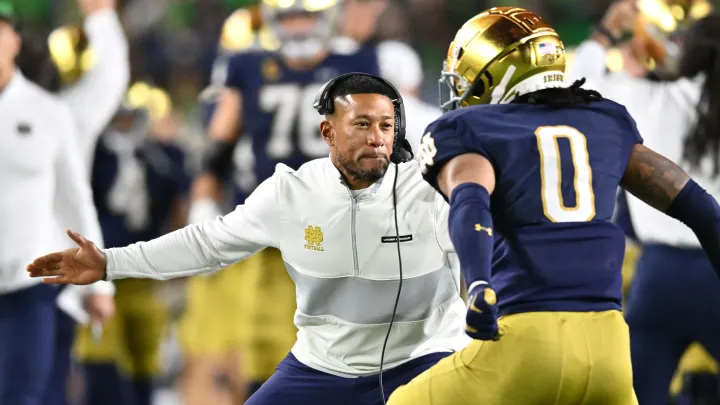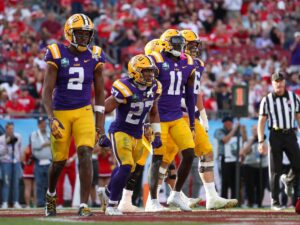
As college football recruiting continues to grow in both intensity and national attention, the 2025 recruiting class has begun to take shape, and there’s one name at the top of the rankings that stands out: Marcus Freeman and the Notre Dame Fighting Irish. Under Freeman’s leadership, Notre Dame has surged to the top spot, fending off traditional recruiting powerhouses like Ohio State and Clemson, two programs that have long been synonymous with elite talent acquisition. Freeman’s success in the 2025 recruiting cycle marks an impressive achievement for both the program and the coach, as he builds momentum toward establishing a sustained period of dominance on the recruiting trail.
Notre Dame: A New Era Under Freeman
When Marcus Freeman took over as head coach of the Notre Dame Fighting Irish, many were curious about how his recruiting strategy would differ from his predecessor, Brian Kelly. Freeman, a former player and coach at Ohio State, brings a fresh and dynamic approach to South Bend, and the results are already visible. With the 2025 class currently ranked No. 1 in the nation, Freeman’s ability to connect with recruits and his aggressive pursuit of top-tier talent have proven to be a winning combination.
Freeman’s recruiting philosophy centers around not just finding the best athletes but also identifying players who fit the culture he’s building at Notre Dame. The Fighting Irish have always been known for their tradition and academic excellence, and Freeman is using those values to attract recruits who not only want to compete at the highest level but also thrive in a unique environment. His emphasis on relationships, integrity, and development has resonated with high school prospects, leading to an impressive list of commitments.
The 2025 class for Notre Dame features a mix of blue-chip talent at every position, from elite quarterbacks to dominant defensive players. Freeman’s staff has made significant inroads with recruits from across the country, solidifying their position as one of the nation’s premier programs. The commitment of top-tier recruits, particularly on the defensive side of the ball, shows Freeman’s continued focus on building a championship-caliber defense, a hallmark of his coaching philosophy.
Ohio State: Consistency at the Top
As Notre Dame surges to the top of the recruiting rankings, Ohio State remains firmly entrenched near the top of the list, with the Buckeyes sitting comfortably at No. 2. Head coach Ryan Day continues to keep Ohio State in the conversation for elite prospects year in and year out. The Buckeyes’ ability to consistently land some of the best high school talent in the nation has been a key factor in their sustained success in the College Football Playoff race.
Ohio State’s success on the recruiting trail is well-documented. With a track record of developing NFL-caliber players and a reputation for success in the Big Ten, the Buckeyes are an attractive destination for high school prospects. This year’s recruiting class is no exception, as Day and his staff have secured commitments from top players across all positions, including some of the best offensive and defensive talents in the country. Ohio State’s offensive prowess, combined with its ability to field a strong defense, makes them a perennial powerhouse on the national stage.
Ohio State has continued its trend of success by securing several elite skill players in the 2025 class, including five-star wide receivers and running backs, who will give the Buckeyes a potent offensive attack in the coming years. On defense, Ohio State has also bolstered its commitment to building a dominant unit, bringing in highly-rated defensive linemen, linebackers, and defensive backs.
Clemson: Rebuilding and Reaffirming Dominance
Clemson, under the leadership of head coach Dabo Swinney, has also remained one of the nation’s top recruiting programs, with the Tigers currently sitting in third place for the 2025 class rankings. Swinney’s program has experienced a slight dip in performance over the past couple of seasons, but the Tigers have remained a dominant force in recruiting, and their 2025 class reflects a renewed sense of energy and focus.
Clemson’s success on the recruiting trail can be attributed to Swinney’s ability to cultivate a family-like atmosphere and his program’s commitment to developing players both on and off the field. The Tigers are known for producing top-tier talent at almost every position, and their strong history of success in the ACC and national championships makes them an attractive destination for top prospects.
The 2025 class is a strong one for Clemson, with commitments from several high-profile players on both sides of the ball. Clemson’s defensive prowess has been a cornerstone of its success, and the Tigers are once again focusing on securing elite talent in the trenches, where they have developed some of the nation’s top defensive linemen in recent years. On offense, Clemson is loading up with high-level quarterback and wide receiver talent, ensuring that they will continue to be a force in the ACC and on the national stage for years to come.
The Landscape of the 2025 Recruiting Cycle
The 2025 recruiting class is shaping up to be one of the most competitive in recent memory, with a handful of programs vying for the top spot. While Notre Dame, Ohio State, and Clemson have solidified their positions near the top of the rankings, other schools are not far behind. Programs like Alabama, Georgia, and Michigan have also made significant strides in the 2025 class, making the race for top recruits even more exciting.
What makes the 2025 cycle particularly intriguing is the increased level of competition among the nation’s elite programs. As the NCAA continues to evolve with the introduction of new rules and the transfer portal, recruiting has become even more important. The ability to secure commitments from top prospects early in the cycle can give programs a significant advantage, but it also means that the recruiting landscape is in constant flux.
For programs like Notre Dame, Ohio State, and Clemson, their success in securing top recruits is a reflection of their sustained excellence both on and off the field. These schools have established themselves as premier destinations for high school talent, and their success in recruiting ensures that they will continue to compete for national championships in the coming years.
What’s Next for Notre Dame, Ohio State, and Clemson?
As the 2025 recruiting cycle continues to unfold, the focus will shift to how these top programs manage their classes and position themselves for future success. For Notre Dame, the question will be whether Freeman can maintain this level of success on the recruiting trail and turn it into a national championship contender on the field. Freeman’s ability to develop relationships with top recruits has been key to his success, but he will need to show that he can consistently translate that talent into victories on the field.
For Ohio State, the challenge will be continuing its dominance in the Big Ten and competing for national titles with a roster full of elite players. Day has built a powerhouse, and maintaining that success will require continued focus on both recruiting and player development.
Clemson, on the other hand, will be looking to prove that it can return to the level of dominance it once enjoyed in college football. The 2025 class represents a critical moment in the program’s trajectory, and Swinney will need to ensure that Clemson’s pipeline of elite talent continues to fuel its rise back to the top.
The 2025 recruiting cycle has proven to be an exciting and competitive race, with Notre Dame, Ohio State, and Clemson leading the charge. Marcus Freeman’s ability to take Notre Dame to the top of the recruiting rankings is a testament to his vision, leadership, and understanding of what it takes to compete at the highest level in college football. As the recruiting class continues to evolve, it will be fascinating to see how these programs leverage their talent and build for the future. The battle for the best recruits may be fierce, but the rewards for these programs will be immeasurable as they continue to shape the future of college football.





